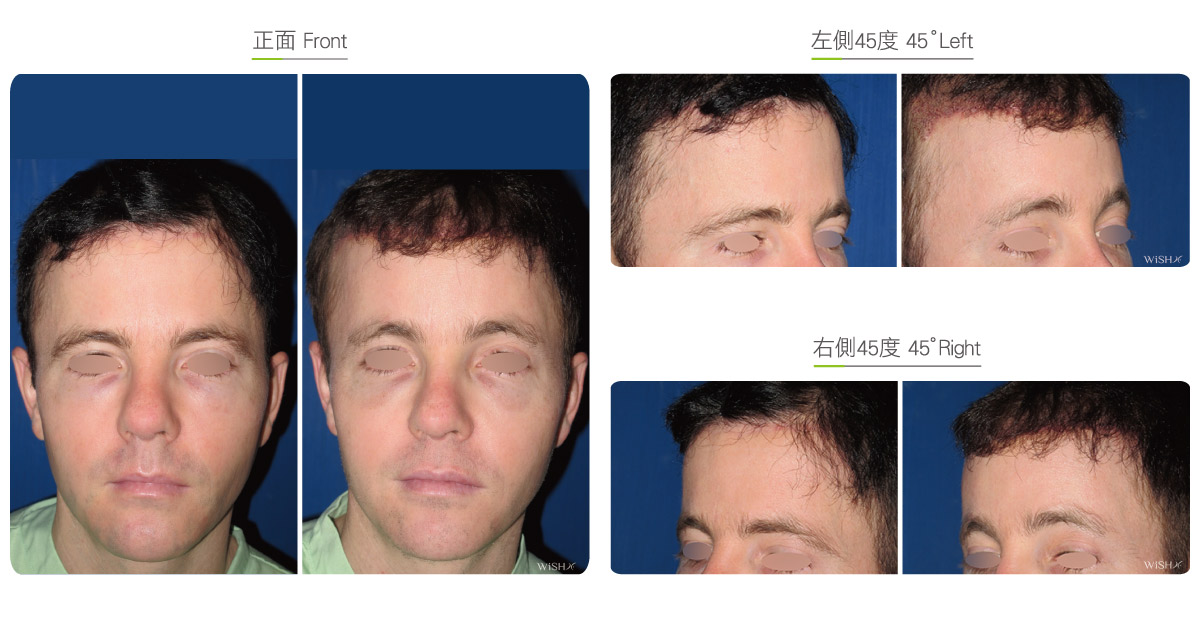Hairline Lowering Surgery
The hairline is the starting line of the forehead and is the uppermost part of the face. Because the whole face is equally divided by the hairline, eyebrow, columella, and chin horizontal line, namely the golden face proportion, the hairline determines the upper one-third visual area; therefore, its importance cannot be ignored. Common hairline problems that are in predominantly too low a position give rise to a narrow forehead or short glabellar space, which is significantly elevated by endoscopic forehead lift with Endotine fixations or bi-coronal forehead lift. However, a few patients have a congenitally high hairline that leads to a long upper one-third of the face or hair loss that causes a receding hairline and thus too wide or high a forehead, which requires hairline lowering surgery to improve the visual esthetics and proportion of the face.
Traditional treatment of a high hairline is hair transplantation, which, similar to male baldness surgery, is conducted by transplanting occipital hairs to the forehead hairline. However, hair transplantation is relatively complicated and time consuming and also difficult to maintain, likely inducing regional hair loss or an irregular hairline, which makes many patients hesitant. Currently, for females or male non-baldness high hairlines, Dr. Chuang performs the latest hairline lowering surgery combined with Endotine fixation to comprehensively lower the hairline, which prevents the risks and side effects of traditional hair transplantation. The surgery is conducted by completely dissecting the boundary of the hairline and forehead skin and detaching extensive scalp aponeurosis posteriorly via this incision till the scalp center to separate the frontal one-half of the scalp from the periosteum, cutting via electric cautery the aponeurosis surface to release the scalp to maximal extensibility, and advancing the loose scalp to the new hairline position and fixating with Endotine implants before excising the excess forehead skin and closing the hairline wound.
This surgery capitalizes on scalp extensibility to the lower hairline, so scalp elasticity and condition determine surgical results. Generally, due to the relatively hypertrophic and less extensible male scalp, the hairline can be lowered by approximately 0.5–1 cm on average; since the female scalp is congenitally soft and elastic, the hairline can be advanced by 1–1.5 cm. Moreover, patient age is critical to surgical results. Elderly patients have a generally looser scalp than younger patients, and surgical results are also more distinct. Apart from changing the hairline level, this surgical incision is used for combined forehead or eyebrow lift in some patients with forehead laxity to obtain a concurrently youthful appearance.
Surgical conditions
Duration
- Type of anesthesia: General anesthesia
- Type of incision: A 15-cm incision at the margin of the hairline
- Recovery: 5–7 days
- Removal of stitches: 10–14 days
General instructions
No food and water on the day of surgery
- Fast from food and water for 8 h preoperatively on the day of operation.
- Avoid smoking for 1 month preoperatively.
- Avoid smoking, alcohol, and irritating foods for 1 month postoperatively, and avoid strenuous or excessive activities.
- Avoid hair dying or perming for 2 months postoperatively.
- Avoid heavy massage to or squeezing of the forehead for 3 months postoperatively.
Ideal candidates
- Patients with a congenitally high hairline
- Those with an exceedingly high or broad forehead that affects the face proportion
- Those whose hairline has receded from hair loss
- Those with non-genetic or hereditary mild forehead balding
Possible complications
- Scar proliferation
- Regional hair loss
- Scalp numbness
- Poor wound healing
Surgical advantages
-
Surgical results are stable and long lasting.
-
It avoids the risks and complications of traditional hair transplantation.
-
Postoperative recovery is rapid, and there is no need for special nursing.
-
The scar is concealed at connections between the hairline and forehead skin and is less noticeable.
-
It changes the facial proportion without altering any facial plastic surgery or facial bone reduction effects.
Surgical drawbacks
-
The hairline scar may become hyperplastic or visible.
-
Regional hair loss may occur near the incision.
-
It is not suitable for patients with sparse hair.
-
The scar may be noticed in case of future forehead hair loss.
-
The scalp may present temporary or permanent numbness.

